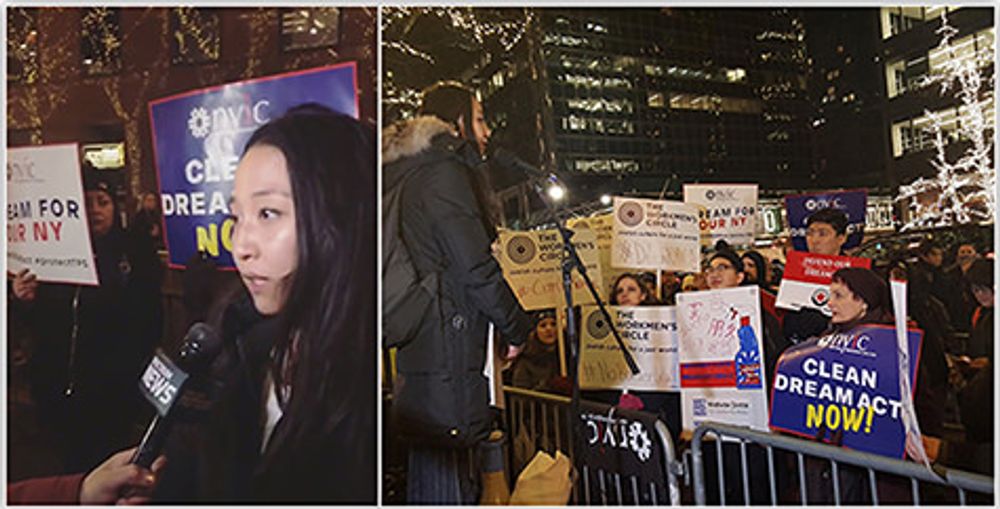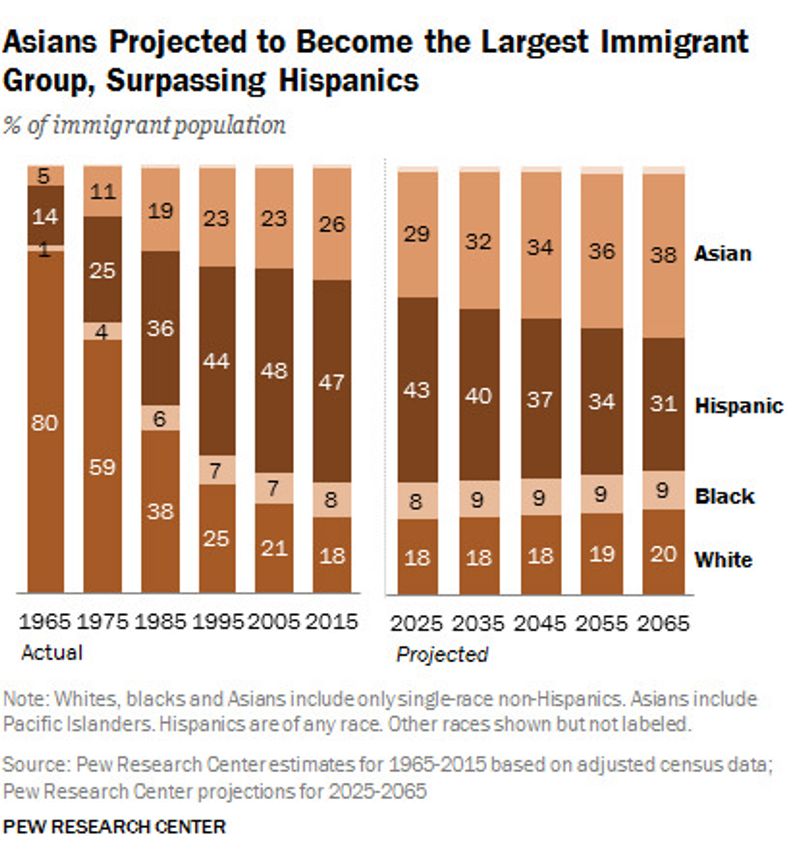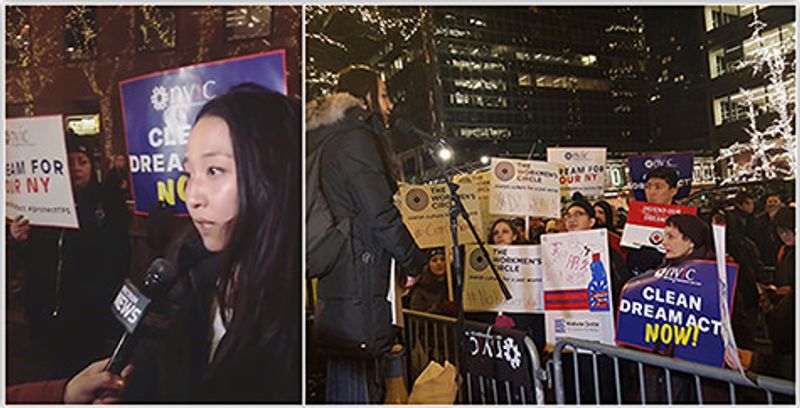Blog
Trump keeps pushing the limits of American Whiteness

Forget the orange hair. Donald Trump wants to get his white on. Or at least keep it where it’s at.
There is no other way to look at it.
Trump’s immigration agenda is all about stopping the inevitable in the U.S.
Every reputable demographic study knows the reality. At some point by mid century, around 2050 or so, earlier in some places, the minority will become the majority in this country.
That’s just a short generation away. Barron Trump’s world.
I know many Asian Americans, like Filipinos for one, have issues with the broader term “Asian American.” But it is the umbrella in our political cocktail.
Without it, we’re all smaller than small. With it, we’re part of a group 21 million large–and growing.
In 2015, the Pew Research Center said Asian Americans will be the largest immigrant group in America, if current trends and policies continue.

As I wrote in a previous post, this is the trend predicted by Pew that shows our dramatic rise as a community, from less than one percent in 1965, to six percent in 2015, to more than double again–14 percent of the total U.S. population by 2065.
But you don’t have to wait 40 years to celebrate. You can start celebrating now.
So consider what all the talk in the Senate over the recipients of DACA (Deferred Action on Childhood Arrivals) specifically, and on immigration in general, is really about.
Anti-immigrant Trumpsters and Republicans so desperately wanting to stop the inevitable.
They don’t really care about the DACA crowd. But they do care about so-called “chain migration and the visa lottery.
And they want that $25 billion wall, as if that will help. If anything, it will build a symbolic anti-Statue of Liberty.
The spitting image of “We don’t want your kind.”
It’s hateful, but Republicans have the majority and it looks like Democrats are reluctantly agreeing to some border security spending–but not a border wall–in order to protect the 700,000 or so covered by DACA and provide the compromise “pathway to citizenship.”
The tougher issue is the proposed end to petitioning for mothers, fathers, or older siblings.
This is exactly how Asian American families, especially my own Filipino immediate family, built our toehold in America.
And now they want to end that?
Even after some of us are being forced to wait for 20 years or more for visas to become available?
THE COURTS STEP IN
Fortunately, a democracy has checks and balances.
The courts continue to block Trump on all his questionable moves against people of color and minorities. Rights are no small thing.
From the travel ban to DACA, the Trump pattern is clear. Trump tries to reverse commonly accepted norms by executive order or legislative bullying, but then gets stopped by a court’s last-minute sense of judicial sanity.
We saw it again this week.
Trump’s dump of DACA was declared a no go by U.S. District Judge Nicholas Garaufis in Brooklyn, who ruled that DACA cannot end in March as the Republican administration had planned.

Garaufis didn’t say Trump couldn’t eventually shut down DACA, but said the administration’s reasons last September were too arbitrary. The judge then ordered the administration to continue processing DACA renewal applications as it had before the Trump action.
The decision is similar to a Jan. 9 ruling by U.S. District Judge William Alsup in San Francisco that DACA must remain in place while litigation challenging Trump’s decision continues.
The legal battle to save DACA has been mounted by attorneys general from California, Maine, Maryland, Minnesota, the University of California, New York, and DACA recipients. Trump can, as they say, hold his horses, while those cases keep fighting for the Dreamers.
The Trump administration curtailed accepting renewal applications last year on Oct. 5. But Judge Alsop’s ruling allowed anyone with DACA status on Sept. 5 the right to renew.
That’s the key point for all you DACA recipients reading this. Keep applying while you still can, as if Trump did nothing last September.
Because the wheels of justice on this issue are turning.
The Supreme Court on Friday is due to consider whether to take up the administration’s appeal of the San Francisco ruling.
The court could announce as soon as Friday afternoon whether it will hear the case. And, of course, the Supreme Court now has another conservative justice with Trump appointee Neil Gorsuch.
So where does that leave us?
Crossing our fingers. And remembering history.
THE IMMIGRATION AND NATIONALITY ACT OF 1965
There was a reason the 1965 immigration law was passed 53 years ago.
There was a moral sense of duty to do the right thing.
Quite simply, the 1965 law was the immigration reform that redefined America, eliminating the racist quotas based on national origin that allowed immigration from all parts of Europe but put a strict cap from Asia and Africa.
It was our “Come on in” moment. Why should only white immigrants be allowed to have all the fun?
And just think about how relatively easy it was to pass this immigration bill. The House vote was 320-70; the Senate vote 76-18. In all, 74 percent of Democrats and 85 percent of Republicans voted for the bill.
When do you get that kind of partisanship for anything these days? The naming of a post office?
After the Civil Rights Act of 1964 and the Voting Rights Act of 1965, society was opening up. And America was ready to change its racist immigration laws.
America was always good at race control through immigration. The hand was always tight on the spigot. Chinese immigrants, mostly male laborers, had been the largest foreign-born group in California, Oregon, Washington, Idaho, and Nevada in 1880. But the Chinese Exclusion Act changed all that in 1882.
When Filipinos, as colonized U.S. nationals, flooded the fields in California during the Depression, it was the same thing. Brought over as a male labor force, they took jobs from whites, and because there were few Filipinas, they married white women. It started an anti-Filipino fervor that led to the Tydings-McDuffie Act, which rebranded the Filipinos as aliens and subjected them to repatriation.
Racist laws are nothing new in America.
The Immigration and Nationality Act of 1965 was the way to make up for all that, ending the artificially repressed generations of Asian Americans.
And no one seems to have expected what would happen.
President Johnson was telling folks when he signed the bill that it would not alter America. Sen. Ted Kenne dy on the Senate floor downplayed it: “The ethnic mix of this country will not be upset.”
They had no idea.
When you put an end to “immigration interruptus,” we exploded.
Just look at America’s population if the 1965 law had not passed:
- Whites: 75 percent
- Blacks: 4 percent
- Hispanics: 8 percent
- Asians: Less than 1 percent
That sounds like an America for the people who talk about a not-so-great wall and use the term “illegal immigrant” as an act of defiance.
If that’s you, note that there are seven states where pre-1965 conditions exist at 1 percent or less Asian, according to the 2010 Census.
There’s Maine and North Dakota at 1 percent; Mississippi and South Dakota at .9 percent; Wyoming, .8 percent; West Virginia at .7 percent; and Montana at the bottom with .6 percent.
Imagine the visitor bureau slogans: Go to the Dakotas, where it’s still 1965 for Asian Americans!
That’s where Trump and the Republicans want to take us, including our Anglo-American friends. (Thanks AG Jeff Sessions for that ad lib this week.)
If Obama’s critics wanted everything undone because we were in post-racial America, Trump is heralding a new phenomenon—“pre-racial America.”
Whatever you want to call Trump’s vision, or anything being debated in Congress now, it is just in denial for what America has become in 2018 and beyond.

Emil Guillermo is an independent journalist/commentator. Updates at www.amok.com. Follow Emil on Twitter, and like his Facebook page.
The views expressed in his blog do not necessarily represent AALDEF’s views or policies.
Read Emil's full bio →